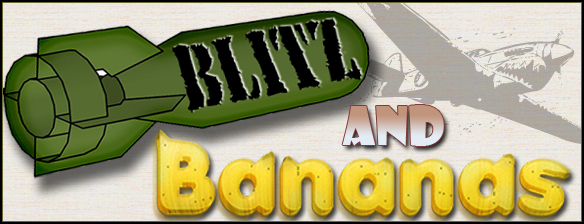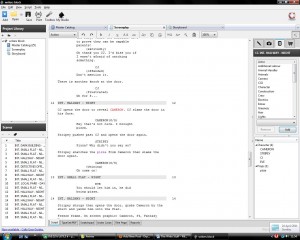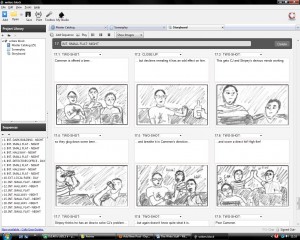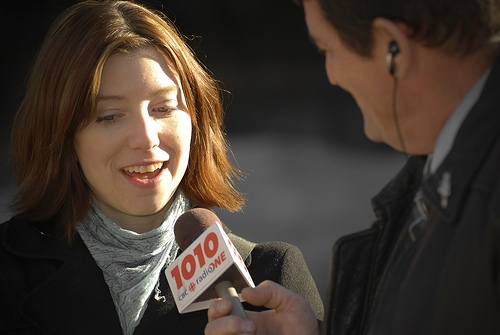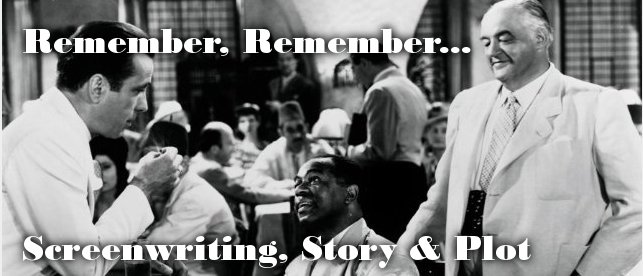
While I’m not going to claim screen-writing divinity (let’s face it, very few people other than myself have even read my scripts), I was pleasantly surprised by the fact that my techniques were supported and reinforced by legends and tutors like Elliot Grove and Syd Field when attending their courses and visiting lectures, and my submissions of ‘homework’ were praised.
What I have not done in this article is delve into the deeper aspects of character development and such like – that’s for another article. This one is just about the story as a whole.
Types of document
You can probably get away with an idea scribbled on the back of a cigarette packet, but lets be honest: when an industry starts to use standard documents, formulated and improved over decades, there is usually a reason. They help planning, understanding and ultimately, quality of the final production.
There are essentially three types of document (not production) that you may write – these may be named differently in different countries, but their underlying content is consistent:
- An Idea
The idea can be as short as a single line, or an entire document containing facts and figures and intended purely to remind you about the fleeting, elusive and easily forgotten thought. For these, it helps if you carry a dedicated notepad around with you. This is the type of thing that you write down at 2:30am after eating too much cheese and pickled-onions.
- A Treatment
The treatment is a first step in putting together a concise explanation of the idea and what you would intend to happen in the production. It has no waffle and tends to be from three to seven (an extremely long one) pages in length, stating very clearly what happens without details. It is usually designed to have impact, so exclamation marks and other attention grabbers are common. This is the type of document that you would give to a studio executive who intends to read your own and two-thousand others on the same day.
- A Script
The script is where you bring it all together and expand on the actual happenings that take place in your treatment. Here, you ‘slow down’ and spell it all out in visual description of events (not details, you are not writing a novel) and all of the dialogue. An script formatted to industry standards equates to about one minute of screen time per page. You do not include instructions to actors (even parenthesis, which are accepted in some schools of thought, tend to be blocked out by actors before reading the script) or the cameraman*.
* Take these last two with a pinch of salt for our environment. In the amateur and independent world, you may be the actor, DoP, director and producer so you may actually have jumped straight to a shooting script for your own benefit right from word go.
It should be noted that this does not include the various type of script that you may write, each of which has a different purpose for different types of film crew in actually planning for the final production (e.g. script, shooting script, sound script etc.)
For writing, I’d advise looking at a dedicated script writing tool rather than a word processor. I have used Word, Open Office and Pages in the past (this latter actually has a dedicated ‘script’ template, so it was very good), but at the end of the day a dedicated tool is a dedicated tool. They tend to offer lots of value added advantages over a more generic product. To get started, I’d always advise Celtx (pronounced Kell-Tex – it’s a accronym for Crew, Equipment, Location and XML) as it is desktop, mobile and web based, but most importantly, free.
Story and Plot
At a technical level there is a huge gulf between the idea of ‘story’ and ‘plot’ and yet these are two words which incorrectly get used interchangeably. When a cinema-goer comes out of a disappointing film and claims that the director ‘lost the plot’, what they usually mean is that they lost the story – the fact that the film started, had a middle and then ended with a conclusion means that the plot was actually [probably] OK.
- Plot
The plot is the easy bit – this is essentially the actual words that you write down in your script including visual events, sounds that are heard, dialogue that is spoken etc. This is also the bit which utilises the traditional concept that you even learn in school: it must have a beginning, a middle and an end. Unless you are going really art-house, pretty much every film will have an understandable plot. The plot must also however, be the carriage for the…
- Story
The story can be far more elusive – the story is what the film is really about, not just what is happening on screen. Using a comic metaphor, the story is ‘boy meets girl, boy loses girl, girl meets someone else, boy temporarily wins girl back before sacrificing himself for girl’s happiness with the other boy’ (or, if you a Red Dwarf aficionado, swap out boy with large green blob). There are literally hundreds of films with this same story (er, thousands?): some absolutely abysmal, but also some classics (there is a little known film called Casablanca which comes to mind here). They may all have the same story, but they are all still different because the plot tells the same story in different ways.
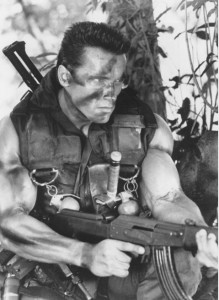
Just because your film tells a story however, does not mean that it needs to be easy to see. Some elusive stories get the audience returning year after year – they enjoyed the film, they don’t know why they keep going back, but they do: perhaps it is because each time they are getting ever so slightly closer to the truth (“I see something different each time”). I remember Elliot Grove admitting in regards to one film he used in a course example, that it took him fifteen years to eventually see one particular story.
Without trying to be too insulting to certain parts of the world, the final cut of a film often reflects the ability to actually see the story by fee-paying audiences. Films in Europe / the UK can be far deeper than those of the United States for example, where test screenings often get negative results because the audience does not understand the underlying story (e.g. at the last minute, the classic SF film Blade Runner had to be given a Phillip Marlow style VO to explain what was going on because of the reaction of US test audiences – you can’t get a more blatant story-assist than that).
Conversely, action films, while having a simple story (girl is kidnaped, boy invades small country, boy kills everything that moves, boy saves girl) relies almost completely on plot because the story is being worn on its sleeve.
The Four Tools
There are four tools which are used to craft an effective screenplay:
- Character
- Dialogue (what the characters say)
- Actions (of characters etc.)
- Settings (the environment, and what environments do)
The screenwriters job is to take a combination of these four tools and stich them together in a seamless manner. Imbalance the stitching (e.g. have a character do or say something inappropriate to the setting) confuses the audience and reduces the effectiveness of the screenplay.
The Four Social Stages
Similarly, there are four social stages in which a story can be set. A warning should be issued here however, as while these four are the generally recognised social stages, what they actually compose of can vary between screenwriters. Some recognise the stage as purely consisting of social interaction (e.g. the social interactions of village life are obviously very different from those of a bustling city), but others also include levels of technology (e.g. a man hunting in the wilderness with a long-bow, would suddenly become City simply because he is carrying a mobile telephone…)
- Wilderness
e.g. a man, the only hope, brings a divine revelation to society. A typical ‘superhero’ character story.
- Village
e.g. a small environment. One speaker, with social boundaries. The classic hero is an outsider who is considered a threat to everyday life. The hero, after completing the story, usually leaves alone.
- City
e.g. a wide range of social classes. The hero tends to be ‘average joe’ who encounters or witnesses an injustice, and who then goes on to fight for justice.
- Oppressive City
e.g. often the hero is an anti-hero who likes to go unnoticed. The hero witnesses a crime by a person in power, or is alternately a bumbling and inept hero who stumbles into something he shouldn’t. A city environment, but where things have started to go wrong, possibly before a total social breakdown and loop back to Wilderness.
Wilderness, Village and City (and sometimes ‘Town’, a mix of the two) are reasonably easy to understand. The Oppressive City begins where the city leaves off and some elements of paranoia, untrustworthy officials and conspiracy begins. It could be argued that Chinatown, set in the 1930/40 period is City based, while the use of corrupt city officials means that it is actually Oppressive City.

The social stage may seem irrelevant, but it again comes back to what the characters are doing and saying, and the effects of the environment upon them. Have any of these aspects not meet the defined social stage (without good or explained reasons), and confusion ensues once again. At the same time, mix social stages (e.g. placing one hero into a different social stage) correctly and new stories arise – the key is believability.
The Premise
A standard approach in trying to establish the premise of a story, is to try the ’25 word’ approach (this is not exact, it really just means ‘short’). This dates back to the US TV guide which essentially stated that if you can’t summarise your program in 25 words or less, you would not be included in the TV guide listings.
The basic (loose) format for writing your Premise under these conditions is:
This is a story about [who, or an occupation?] who [what they want to do, the goal] but [the obstacle] – [the final outcome].
For example, if we were try and summarise Casablanca under these conditions, it might go something like this.
This is the story about a bar owner in Casablanca who wants to sit out the war quietly but whose life is turned upside down by a returning old lover hunted by the Nazis – his only thought is to get her to safety.
My view is that this actually says far too much for a TV guide (remember our discussion on story and plot – we are talking about the US here) and gives away a good part of the story, but it is a good jumping off point in the creation of a story. Using this example, we can examine each section of the statement and write up a list of all of the conditions which would need to be in effect for these things to exist or progress.

For example, see how many of these are answered by your previous knowledge of the film, but are questions that you might logically try to answer based upon this short premise:
- This bar owner – what’s he like? What is is history? Does he have friends, colleagues, employees?
- What is he doing in Casablanca? What brought him here? Is he running from something?
- Why does he want to sit out the war quietly? Is he a coward, a deserter, a criminal? Why isn’t he being patriotic?
- What prompted the old lover to reappear? Why is she being hunted? Who is she, what is she, what is her history with the hero?
- Why does he want to get her to safety if she is a past love? Does he still love her? Is that in fact why he is in Casablanca?
- Setting wise, what is it like in Casablanca at this time? Are there any key historical issues to consider? Are there elements of the story which are only plausible (or are implausible) in this setting?
As you can see, it does not take much to get the ball rolling, yet every one of these questions is directly related to a single element of the premise statement.
What came first, the story or the plot?
Almost exclusively in amateur or independent screenwriting, the story comes first. It is the story which the plot is ultimately intending to tell with each of the events that occur to the characters.
There are situations however, where you will have some of the plot, or at least a clear definition of the environment, already established into which you must shoe-horn a story. In these situations, it is usually because you are writing into a defined story environment (e.g. a long running TV show) , or an actual, factual set of historical events (e.g. Blitz and Bananas). Regardless, you need some sort of ‘bible’ – these are detailed documents in the former case, and simple historical fact in the latter.
What do I write?
The big question which really comes down to you. There are two points I’d make about this however:
- First, there is no such thing as writers block. It’s all about confidence. Put something down on the page, even if you don’t use any of it in the final piece. The important part is to get a page that has something on it – it will gradually build as you start to think.
- Second, don’t be afraid to experiment. You’ll have two dozen ideas before something takes shape that seems feasible – try the final exercise and see what you come up with.
Write about something you know…
Never was a more misleading statement ever made. To quote a Raindance promotional paragraph, “If everyone only wrote about something they knew, we’d be inundated in teenage angst stories…oh, hello Hollywood“.
While the statement is true, you’d be amazed what you actually know. Don’t artificially restrict your boundaries to your immediate experiences (which is the big, misleading result of this statement). Take a look over your past, your skilled knowledge, your hobbies, the skills of your friends and family which you have been peripherally exposed to and expand. It’s amazing how much you do ‘know’ even without needing to do a few months intense research.
Exercise
- Get the newspaper, preferably something local with people stories rather than the headline that another European country is about to go bankrupt.
- Go through it quickly, page by page, and ring people stories regardless of their importance.
- Choose two stories and try to combine them – you can do this by swapping characters, events and locations.
- Can you add an additional element which ties the two together, and starts to build a story that you film as a drama?
An example from a course I took used the London Evening Standard. One story was about a business man who was killed by a lorry driver using the hard-shoulder while he was changing a wheel; the other was about a dairy closing down in Dartford. We ultimately came up with this:
Links to Craig’s other articles from the Raindance Technical Certificate course :
Part One can be found HERE
Part Two can be found HERE
Part Three can be found HERE
Part Four can be found HERE

